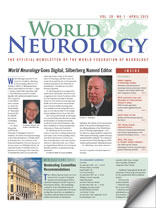The Journal of the Neurological Sciences enjoyed another year of growth with a 6 percent increase in submissions in 2012. During the last 15 years, the journal has shown enormous growth and improved impact throughout the medical world. The impact factor rose from 1.398 in 1998 to 2.353 in 2011. Submissions rose to 1,459 in 2012.
These indicators are a reflection of the journal’s growing importance as an international journal covering all aspects of neurology. The journal’s broad scope includes studies in neuromuscular diseases, demyelination, dementia, infections, stroke and cerebral circulation, degenerative diseases, neurogenetics, neoplasms and metabolism in both clinical neurology and the basic sciences.
The statistics demonstrate the journal’s growth. In 2006, the electronic submission and review process was implemented. Submissions averaged 400 annually from 1998 to 2005. By 2012, the journal received 1,459 submissions with double-digit increases in every year but 2011 and 2012. Thus, the electronic submission and review process have made a major contribution to growth but cannot explain all of the continual growth.
The annual acceptance rate declined steadily from 49.5 percent in 1998 to 23 percent in 2012. The annual rejection rate increased steadily from 26.6 percent in 1998 to 78 percent in 2012. The editor-in-chief started triaging manuscripts in 2009 because of the significant increase in submissions annually. The “triage” rate increased from 43 percent in 2009 to 58 percent in 2012.
Four hundred and eighty-four articles were published in 12 volumes including one special issue. This year’s special issue was 322.1-2 (November 15) Vascular Dementia. Guest editors: Amos D Korczyn, Natan M. Bornstein and Alla Guekht.
The evolution of the journal is reflected in the changing demographics of the contributors and reviewers. While the five leading countries in submissions in recent years continue to be China, Japan, U.S., South Korea and Italy, an increase in submissions from countries and regions including Africa, Egypt, Iran, Jordan, Lebanon, Qatar, the Russian Federation, the Arab Republic and the Caribbean indicate a trend that demonstrates the journal’s expanding global presence and impact factor.
The top 5 ranked countries for accepted manuscripts remained the same: U.S., 17 percent (56 manuscripts); Japan, 12 percent (41 manuscripts); China, 11 percent (37 manuscripts); South Korea, 8.5 percent (28 manuscripts); and Italy, 6 percent (21 manuscripts).
The five countries with the highest number of submissions included People’s Republic of China with 224 = 15 percent; Japan with 213 = 14.5 percent; the U.S. with 148 = 10 percent; South Korea with 114 = 8 percent; and Italy with 109 = 7.5 percent. There was a significant increase in submissions from China starting in 2011 and from South Korea in 2012. U.S. submissions nearly tripled from 51 in 1998 to 148 in 2012.
Basic research defined as employing no human subjects or tissue/material remained consistent. It accounts for 8 to 9 percent of the submissions annually.
For the 484 manuscripts published in 2012, original articles continued to dominate with 68 percent followed by short communications at 18 percent, reviews at 4.5 percent, letters to editor and invited response letters at 4.5 percent and book reviews at 5 percent.
These indicators are a reflection of the journal’s growing importance as an international journal covering all aspects of neurology.
Disease types for all submitted manuscripts included cerebrovascular, 25 percent; inflammatory/MS, 16 percent; movement disorders, 9 percent; neurodegenerative, 10.5 percent; peripheral nerve, infections and other, each 5 percent; tumors/neuro-oncology and muscle/neuromuscular, 4 percent; headaches, 2.5 percent; seizures/epilepsy, 2 percent; motor neuron, 3 percent; dementia/aging and trauma, each 2percent; developmental disorders, 1.5 percent; metabolic, 2 percent; environmental/toxic, < 1 percent; medication/iatrogenic, < 1 percent.
Disciplines for all submitted manuscripts were clinical, 40 percent; neuroimaging, 11 percent; genetics, 11 percent; cell biology, 6.5 percent; cognitive/behavioral, 7 percent; neuroimmunology, 8 percent; neurophysiology, 5 percent; molecular biology, neurochemistry and neuropathology, each 2 percent; epidemiology, neuroophthalmology and neuropharmacology, each 1.5 percent; neurovirology, 1 percent; neuro-otology, education/history and medical economics, each < 0.5 percent.
The review cycle for the 331 manuscripts accepted in 2012 has remained consistent over the years. Ten percent were accepted without revision. Sixty one percent required one revision. Twenty nine percent required two or more revisions.
An estimated 8 percent of the manuscripts were delayed by late reviews ranging from one week to several weeks. Electronic reminders were sent two days before the due date and every Friday. Alternate reviewers are assigned promptly. As many as 16 reviewers have been invited for some manuscripts.
Ad hoc reviewers were acknowledged for their contribution to the journal in April 315:184-89. More than 4,235 reviewers, including members of the editorial board were invited in 2012; 1,295 = 30.5 percent declined to review, and 1,049 = 25 percent did not respond.
Changes were made to the Editorial Board in 2012. Alla Guekht (Russia) was invited and accepted the invitation to join the board. O. Elwan (Egypt), T. P. Hund (Taiwan), A. Ordinario (Philippines), A. Prusinski (Poland) and A. A. F. Sima (U.S.) rotated off the board.
This will be my last report as editor-in-chief as I am stepping down after 15 years. It has been an honor and privilege to have served in this position for this period of time and to see the growth in size, impact factor and download of articles over these 15+ years.
Lisak is editor-in-chief of the Journal of the Neurological Sciences.


